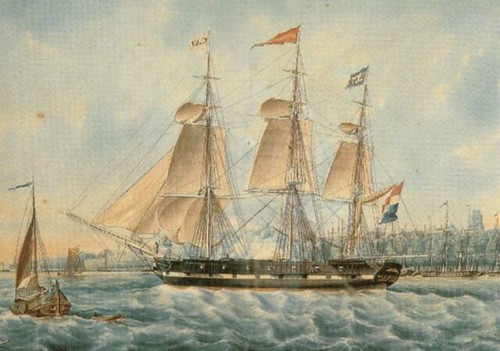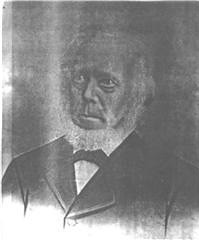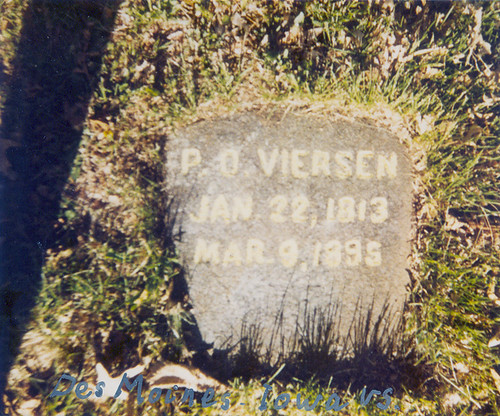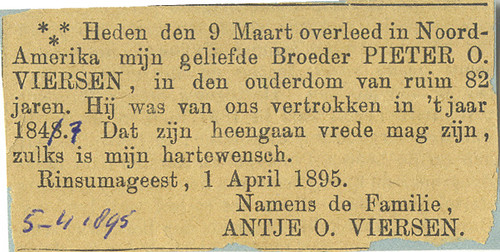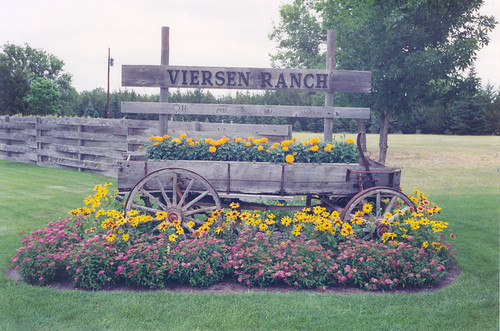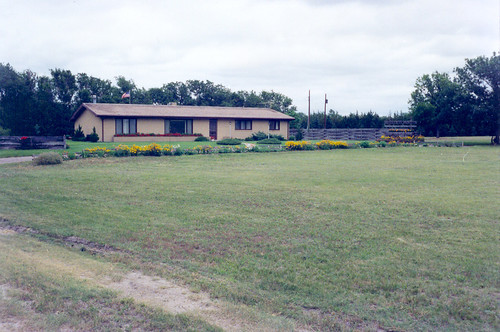This is the first of a series of 12 articles about emigrants from the Frisian municipality of Dantumadeel, who settled in Pella, Iowa. This article was written by Kor Postma and translated by Thys de Jong.
Life in the Netherlands
Pieter Oebeles Viersen was born on January 23, 1813 at Sijbrandahuis. He was the son of Oebele Ypes Viersen and Froukje Piers de Groot. He married on May 24, 1838 in the municipality of Dantumadeel with Tjitske Johannes Wouda, daughter of Johannes Sybes Wouda and Maaike Pieters Wiersma. Tjitske was born on April 14, 1818 at Lichtaard (municipality of Ferwerderadeel).
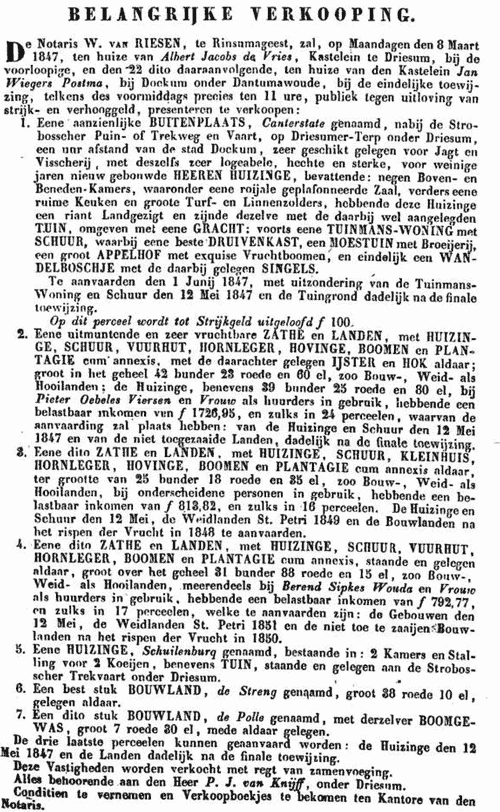
Emigration
When they crossed the ocean they had 4 children: Oebele born March 6, 1839, Maaike born May 20, 1841 – both at Sijbrandahuis (Dantumadeel) -, Froukje born September 21, 1843 and little Johannes born February 22, 1846 both at Driesum (Dantumadeel). They left the harbour of Amsterdam on April 3, 1847 and arrived in Baltimore on June 12, 1847. The captain of the ship Pieter Floria also known as Pieter Floris was J. A. Begeman-Sietzes.
Terrible things happened aboard: disease, cold and homesickness were members of the company. Little Johannes died on the way to the “promised land” on May 25, 1847 from croup. He was buried at sea and with him many others.
Settling in Iowa
The young family settled at Pella, but soon Pieter invested in land and moved a few kilometers northwest of Pella where he lived another 40 years,
In Pella Tjitske gave birth to 2 more children: Johanna on July 21, 1848 and Anna on September 6, 1850. All went well till suddenly on June 3, 1851 Tjitske died at Pella.
Because of the young age of the children (and to not endanger the continuity of his business) Pieter married for the 2nd time with Emeline Jarret Harrell on February 8, 1853 in Pella. She was the daughter of Isaac Harrell and Mary Ann Hollis and was born April 21, 1820. From this marriage 2 more children were born: Mary on December 22, 1853 and Abraham on January 19, 1856. Emeline was the widow of Theodore Cannon by whom she already had 2 children. It must have been terrible when 9 days after the birth of Abraham suddenly Pieter’s 2nd wife, Emiline, died on January 28, 1856 also at Pella.
Again the young family was without a mother and how they managed no one knows, for it was not until 3 years later that Pieter married for the 3rd time. Her name was Sarah Ann Crandall, daughter of Elias Crandall and Mary Coon. The wedding took place on June 9, 1859 in Pella, Marion Co., Iowa. Sarah was previously married with Lovel Starr and had 4 children from that union. She was born on December 14, 1820 in Westford, Chittenden Co., VT.
Their marriage was blessed by the birth of Jacob (Jake) Peter on June 5,1860 at Pella. However, the marriage was not a good move for Pieter because Sarah was a poor housewife and a heavy drinker. It did not take long before Pieter divorced her. Daughter Mary told later that she remembered that a lawyer came from Pella along with a police/judge. There was a lot of talk and a lot was written down. Several neighbours were present, probably as witnesses against Sarah. Shortly after, Sarah moved into her own home and again the family was without a mother. Mary told that she occasionally visited Sarah to see baby Jacob Peter. Sarah died on July 19, 1876 at Pierrepont, St. Lawrence, Vermont.
Five years passed before Pieter married for the 4th time on December 1, 1864 in Pella. This time he married the widowed Mary Elizabeth Metz, daughter of John Andrew Metz and Anna Elizabeth Haxel. Mary Elizabeth Metz was born on April 10, 1828 at Berlin, Germany. She already had 9 children from her previous marriage with John Roth, who was born in Switzerland. This marriage was blessed with 2 more children: Gilbert Wayne born March 12, 1866 and Clara Adelia born September 3, 1868 both at Pella. Pieter died March 9, 1895 in Des Moines Polk Co. Iowa. Mary Elizabeth Metz survived him and died on April 27, 1904 also in Des Moines.
His first and second wives were buried on Pieter’s farm. It’s said the graves were well cared for and and were surrounded by an iron fence.
Pieter held many social and church governing positions and was one of the outstanding persons of the region. He was also known as a good singer and someone who could communicate very well in Dutch. [His mother tongue would have been Frisian so Dutch was a second language for him].
Letters to the home country
Many letters went back and forth to Friesland as long as his mother Froukje Piers de Groot and mother-in-law Maaike Pieters Wiersma were still alive.
From a letter written by Pieter and received on October 13, 1848 in Friesland the following: [To my regret I am unable to exactly translate the letters. The use of words is somewhat differentfrom what I am used to and I have not read a lot of Dutch from that period. Hence all I can do in places is give a general idea as to meaning].
Yes, much longed for parents. brothers, sisters and all of you asked us about religious services, and we are not pleased with that because H. P. Scholte is not a pastor; however 6 elders were chosen and preach in turn and among them is H. P. Scholte. But I do not feel that this is enough. [The next sentence is obscure, but I think it means that there was much discussion about this among the people both old and young and that 6 young men have been brought by the mighty hand of God to study for the ministry].
It’s said that among the van Raalte group there is more flowering [that is that they fared better economically], but we also hear the opposite. I really don’t know but leave it to the wise counsel of God. [This is a reference to Rev. A. C. van Raalte the founder of Holland, Michigan.] The news from van Raalte states that the land is better there, but according to good Americans who have been there this is not true. They say that the land there is all forest and sand, but when it has been made ready for cultivation. I think it could well be good land. Here the soil is black clay. There’s not much chance to sell our produce here, but we do not suffer want. A river is being made navigable and should reach us in 3 or 4 years and people say that then our produce will have more value.
About our climate: the summers are warmer than yours, especially in July and August, and the winters colder. When it freezes here the wind is from the north.
We hear many rumors of war [1848 in Dutch is known as Revolution Year] and that many young people are in military service. Some Dutch people still arrive here but many Americans and the settlements here grow. In 1844 there were no people here but wild ones [Native Americans] but now there is much population. We now live among Americans and like that better than among the Dutch; our children already speak many words with them. People enjoy good health here. The Americans first held religious services with the afgescheidene [seceded]; then amongst themselves first in one house and then in another, and all who like may go. The Americans build many block houses and they are very good; the Dutch build their houses from planks and they are also very good. There are brick makers here and the bricks cost 1 guildre per 100. The fields are protected by fences and that works very well. We see a lot of wild animals here; wolves are no problem, but snakes are dangerous. We hear of rattlesnakes whose bite usually means death. A Dutch lady was bitten by one, but she was healed. In my travels in America I did not see land as good as here because there are many mountains and valleys but also much flat land. Here everything is black clay but throughout America there is much red soil.
Here are a few excerpts from a second letter written by Pieter that was received in Friesland on February 24, 1849:
We received your letter of November 28, 1848, and yes, it’s sad to hear the news that our mother in Lichtaard died. O, that our Lord receives her soul in heaven is our wish. [Maaike Pieters Wiersma died on August 21, 1848 at the age of 76]. Tjitske [Pieter’s first wife] had already expected that from the first letter.
We received your letter in good health and we are all still healthy by God’s blessing, and wish the same for you. You asked if we’ve lost much money, but that is not so because we at first, along with H. Y. Viersen, bought land from H. P. Scholte and we divided that, we 1/3rd and H.Y. Viersen 2/3rds. Half a year later we sold that again with profit for 2 horses, a cow, two calves, two plows. much wheat and oats, and other things. You asked where we sell our goods; a lot is done through trading and as payment for labour, which is how we get our work done. But the way things are now we can not sell much for cash [because] we’d have to travel 30 to 40 hours. We have cows [obscure phrase omitted]; some have no horns while others are not much different than in Friesland. We plow with 2 horses a hand width deep and that gives good produce but I have found the deeper the better, folks here keep the fields clean (weeded) with the plow. I myself like being here and would not trade with a great lord in Friesland because here we can do what we want, and we work for ourselves ,and there are no taxes. Tjitske would rather live in Friesland.
The overland journey here is difficult. First we went from Baltimore by train and then in a trekschip [a ship pulled by horse along a waterway; then again by rail followed by another trekschip; and than with a steamboat to Keokuk folowed by 40 hours on wagons. The fuel we burn here is wood and coal. Yes, noble friends we did get rid of some money. [This is a Dutch understatement for “it cost a lot of money”.]
H. P. Scholte delayed us from reaching our chosen destination and we had to live off our money till we reached it in September 1847. The time for sowing was past, so we sold our land again, and when we did so H. P. Scholte thought to get more money from us. When we sold we had to pay H. P. Scholte another 134 guildres, more than we had known. I think that H. P. Scholte thought that he could sell us more land, but we saw that he dealt dishonestly with us and looked for other land which we were lucky to find and we are happy with that. We could sell it again but so many people are coming to this state that in 2 or 3 years it will be worth 2 or 3 times what it is now. Yes, noble firends we have no money but we suffer no want; we invested in land and what is needed to farm it.
As far as religion and education: it is not grounded in truth here, because they say “just believe” but believe without explanation of what is in their hearts. H. P. Scholte says that he likes people to experience things for themselves, but he speaks of great things and with education it is the same. [I have a sneaking suspicion that Pieter meant something in the last sentence that I am unable to grasp].
We have many wolves here but they do not bother people if they have dogs. Our dog caught a wolf, and I have the pelt in the house. Geert Alberts Dijkstra would like to know who Meindert married. [Geert was born August 16, 1817 in Oudwoude, Kollumerland. He married on March 7, 1853 in Pella Geertje Buwalda. The Meindert referred to is probably his younger brother.] Geert does not live with us but has the best earnings: 15 gulden in a weekend. Sjoed Aukes Sipma from Bornwert [Westdongeradeel] would like to know if his letter from September 1848 arrived, a letter of six “mountains” [pages?] long. [Sjoerd was married with Jansje de Vries, both are buried in Iowa–Sjoerd in 1896 in Orange City, Jansje before 1857 when Sjoerd remarried with Boukje Boonstra]. Yes, noble friends I can understand your sorrow [at being so far from Pieter] and from our side we share that; but I would not like to return [to live] but to be with you again is my great longing. It will be as the Lord wills and we live, but the costs to go to you are too heavy for us; it would cost 2 or 3 hundred guildres but our desire [to do so] is great. Yes, noble friends, I cannot write much of what is between God and my soul, but the Lord is with us of that I am convinced. [The next phrase I cannot translate, but seems to mean that God has not left him alone].
I greet you all and wish that you may receive this letter in good health, we are all healthy. And if there are those who would like to come over let them come on their own and not trusting in others.
It is impossible to publicize all the correspondence between America and Friesland, hence just these excerpts from the first and second letter that Pieter send to the Heitelân [Fatherland].
Pieter’s children
His descendants are numerous for 11 children were born from Pieter’s four marriages. In addition, Pieter was the stepfather of 15.
Oebele married Mary (Polly) Arvilla Starr on October 18, 1859 in Pella. The family was blessed with 10 children: George, Mary Arvilla, Lovel Starr, Minnie, Milton Ernest, Edgar Beecher, Anna Estella, Jennie Grace, Lilian Alice and Ada Jane. Mary was a daughter of Lovel Starr and Betsey Coon and was born on August 18, 1841 in Colchester, Chittenden County VT. Oebele died on January 4, 1929 at Pilger, Stanton Co., Nebraska; his wife Mary died in the same place in November 1928.
Maaike married Gerrit Hookstra [Hoekstra?]on October 25, 1856, probably in Pella. They had 6 children: Peter, Henry, Anna, John, Fredric and Alfred. Gerrit was born around 1831 in the Netherlands. The family lived beside Maaike’s parents Pieter and his 3rd wife Sarah. Maaike died in 1895 at Edholm, Butler Co., Nebraska and Gerrit, as far as known, in 1919.
Froukje married Henry Wagner Yowell on October 25, 1860, probably at Pella. They had 7 children: Calvin Wayne, Francis Jane, Zippora Ann, Allen Lester, Lillie Lauretta, Millard Fillmore and Carroll Ashton. Henry was born around 1837 in Virginia probably the son of William Yowell and Semphonia (Simfrona) Hawkins. Froukje died on May 22, 1912 at Bellville, Republic Co., Kansas and her husband Henry on November 27, 1925 beleivably also in Kansas.
Johanna married Rufus Wing Bearden and had 1 child named Lloyd. Rufus Wing Bearden was born around 1853 in Washington, Wapello County, Iowa and was a son of John and Polly (or Mary) Bearden. The couple had a furniture business in Monroe, Iowa. In 1886 Johanna Pieters Viersen died. Other data about this couple is unknown.
Anna married Hugh Morrison on July 24, 1872 and had 3 children: Willie Hugh, Mamie Elizabeth and Garfield. Hugh Morrison was born around 1840 in Prince Edward Island, Canada. Hugh came with his Scottish parents in 1866 to America. Hugh Morrison and Anna Viersen lived in Jasper County, just north of Marion County, till their deaths and were buried there, Hugh in 1919 and Anna in 1924.
Mary married Charles Albert Parker February 17, 1876 in Pella and gave birth to 4 children: Royal Sherman, Mahlan, Pearl Grace and Minnie Adelia. Mary died on August 9, 1947 in Gorden, Sheridan Co., Nebraska and Charles on March 15, 1941, also in Gorden.
Abraham married on October 8, 1879 Rosetta Clariss Grant at Knoxville, Marion Co, Iowa. They had 5 children: Claude Justin, Maude Ethel, Nellie Leora, Harrison Grant, and Hope. Rosetta Grant was born on September 9, 1852 in Riply Co, Indiana and was a daughter of Hiram Grant and Hannah Towne. Abraham died on March 16, 1946 in Halstead, Harvey Co., Kansas. His wife Rosetta had died there on November 8, 1938.
Jacob (Jake) Peter married Zella Hamilton on December 12, 1889 and they had 4 children: Claude Guy, Harvey Obler, Joyous Jane and John Meryle. Jacob (Jake) Peter died on February 24, 1944 in Maywood, Frontier Co., Nebraska. Zella Hamilton was probably born on October 19, 1870 and died on December 26, 1966 in Nebraska.
Gilbert Wayne married on November 22, 1895 Mary Ina Shull,; they had 2 children: Margarette and Florence. Mary was a daughter of Charles and Matildah Shull and was born in 1870 in Jasper Co, Iowa. The couple lived in Des Moines, according to the 1920 census and probably died and were buried there.
Clara Adelia married William Koeningsberger on November 1, 1888. They also had 2 children: Carl and Hazel. William Koeningsberger was born in August, 1859 in Iowa, the son of John [a German] and Elizabeth Koeningsberger. Clara Adelia died on May 2, 1936 and her husband William on May 11, 1935. They are buried at Woodland Cemetery in Des Moines.
Book ‘Groeten uit Amerika’
This series of articles is also available in Dutch in the book ‘Groeten uit Amerika’. This book can be bought from Kor Postma for €25 including shipping and handling to the Netherlands.
Additions or corrections?
If you have additions or corrections please contact Kor Postma.
